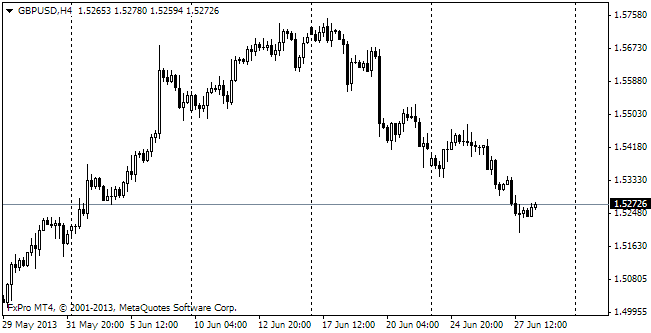EUR/USD
The unemployment statistics proved to be relatively good, but since for the most part they met the expectations, the market didn't see any significant volatility. The US employers increased the number of jobs by 192K in March against the consensus forecast of 199K. Against expectations, the unemployment rate remained unchanged at 6.7%, but this is not bad news as the participation rate grew from 63.0% to 63.2%. Average weekly hours grew more than expected, from 34.3 to 34.5 hr. The current rate already corresponds to the average pre-crisis rates, so we can already speak about returning to the normal workweek schedule in America. The Fed should treat improvement of other parameters of the labour market with the unemployment rate unchanged as a positive sign. fomc stopped targeting this indicator exactly due to the distortion of the picture as the decrease in the participation rate accounted for about a half of the unemployment decline. It means there were negative structural shifts under the veil of superficial improvement of the indicators. The market reaction was mixed. At first we saw growth of stock exchanges and when observers delved into the reports it became clear that the data reflected a picture of steadier growth, which is likely to support FOMC's intention to cut the incentives. eurusd didn't see any considerable changes: after a couple of hours of nervous fluctuations it returned to 1.3700. In our opinion the pair simply wasn't strong enough to go down after the pressure on Thursday. So the single currency found support at 1.3680. Anyway, we get more and more signs of the developed reversal, so we expect that the pair will again come under pressure already this week. Today the risk is posed by the numerous speeches of the ECB officials, who may feel the need in providing more details on the Bank's plans regarding the monetary policy.
GBP/USD
The British pound performed like the single currency – it declined against USD, but by the insignificant 20 pips, down to 1.6575. It's important that the pair closed the week below 1.66, which means returning to gradual decline. Earlier, in the last week of March, bulls tried to bring the sterling back above 1.6700, but they failed to consolidate there because of poor PMIs, which reflected growth slowdown in the country. The general strengthening of the dollar was not in favour of the British currency either. And though it will hardly be very weak against the euro in the coming months, most likely it will depreciate against the dollar.

USD/JPY
usdjpy followed the scenario, we suggested in our Friday's review. The pair came under pressure after the severe growth during the week. The rally in the pair has almost exhausted itself and selling in the US stock exchanges has strengthened demand for risky assets. Besides, don't forget that in Japan the sales tax will be raised from 5% to 8% since April. In the 90s the increase of this tax from 3% to 5% stifled the economic growth for years. The April statistics should be treated with attention. Decline of business activity may signal extension of incentives by the BOJ.

USD/CAD
The Canadian labour market is regaining confidence. Employment grew by 42.9K. Yet, two thirds of this growth are accounted for by part-time employment (+30.1K), while full-time employment grew by 12.8K. Anyway, the tendency is good – employment is growing. For the last 12 months it has increased by 190K, thus making the Loonie-traders think about the possible policy toughening in Canada.
